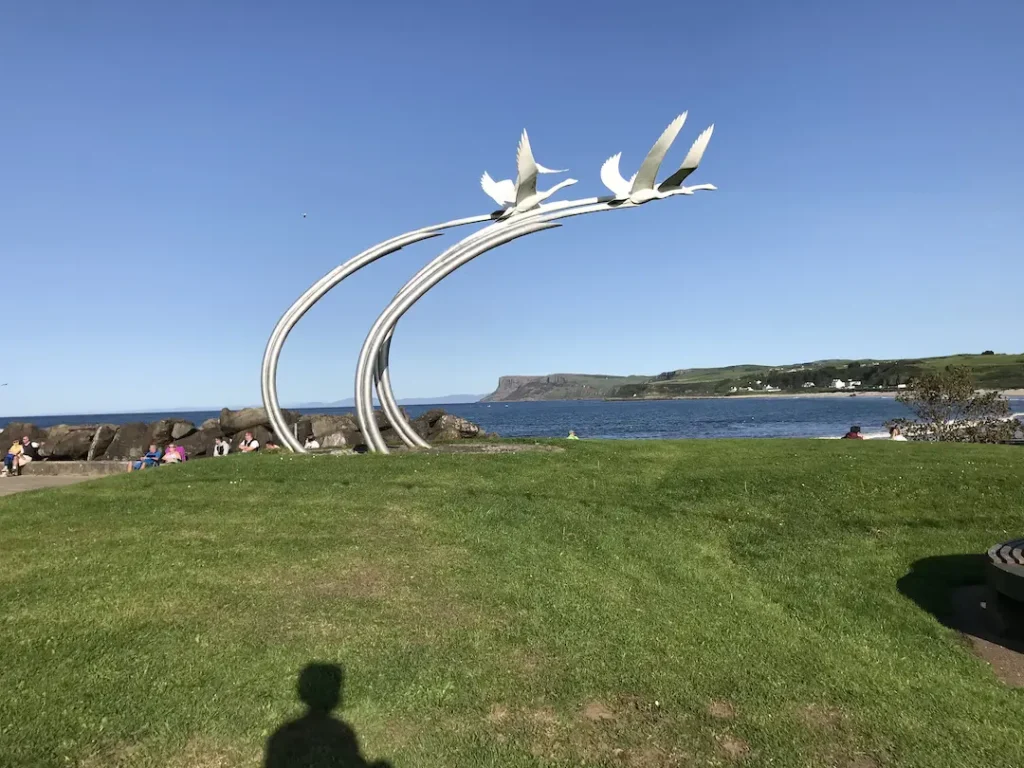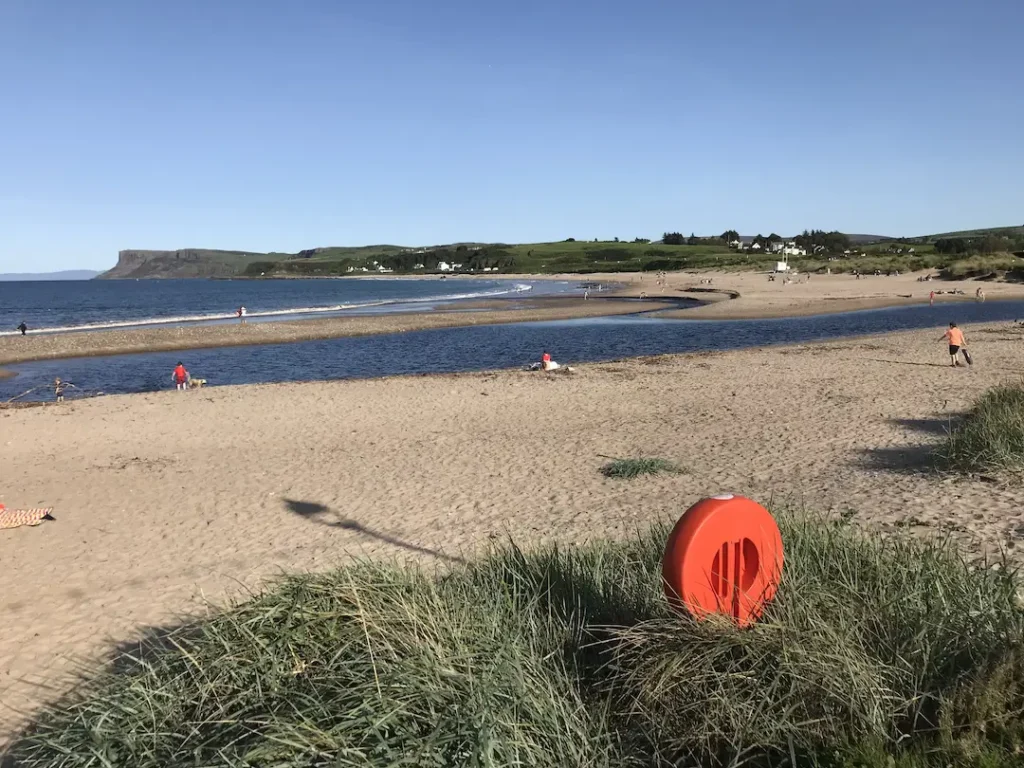Ballycastle
Ballycastle, located on the north coast of Northern Ireland, is a small town nestled in Antrim County. The town is part of the scenic County Antrim Coast, known for its dramatic cliffs, charming villages, and breathtaking beaches. Ballycastle lies between ancient rocks, forests, and glens. The town has five thousand inhabitants, and it is the Causeway Coast’s Eastern Gateway to the Causeway Coastal Route.

Eastern Gateway of the Causeway Coast
The town of Ballycastle is a popular tourist destination located 47 miles north of Belfast along the north antrim coast, often known locally as the Antrim Coast, and 19 miles East of Coleraine.
It is a perfect base for a Causeway Coast Holiday on the northern coast of Northern Ireland and is also a top-rated day-trip destination. Local attractions such as beaches and golf courses enhance the overall visitor experience.
Auld Lammas Fair
Its age-old Auld Lammas Fair has made Ballycastle famous, and the festival celebrates the harvest. In August, the festival, which dates back to the 17th century, attracts more than 150,000 visitors from Northern Ireland and elsewhere to historic Ballycastle.
With hundreds of market stalls that offer all kinds of hand-crafted pieces, produce, and artisan wares, the Ould Lammas Fair is an exciting event to explore. The harvest is celebrated with the music of all locations and types, delicious food choices, sweet and savoury, and many other fete festivities.
Baile a Chaistil
The Irish name of Ballycastle is ‘Baile a Chaistil’, and it means the ‘town of the castle’.
Ballycastle Strand

Ballycastle Strand
The Blue Flag Ballycastle Beach (Strand) offers excellent views of the Mull of Kintyre and Rathlin Island just off the shore. Ballycastle Strand is slightly less than a mile long and is perfect for water sports, swimming and surfing. It is close to Ballycastle town, making it is very popular with both visitors and locals. Although there is no seasonal lifeguard service at Ballycastle Strand, the beach is safe for swimming. From the beach, visitors can enjoy the scenic views of Ballycastle Bay, especially from high points like Fair Head.
The West side of the beach begins at the Ballycastle Marina’s pier, where the Glenshesk River flows into the ocean. The Ballycastle Seafront is an exciting mixture of graciously rounded landscaped gardens running from the Marina to the Foot Bridge that crosses the Glenshesk River and leads to the main beach.
The Eastern end of the beach is at Pans Rock. This fascinating rocky outcrop juts out to the sea and is famous for fishing and rock climbing.
The Ballycastle Golf Club offers a picturesque 18-hole links layout with stunning ocean views and excellent facilities, making it an essential stop for golfers visiting the region.
Heritage
Ballycastle’s heritage is vibrant, and there are more than 50 buildings listed within the ‘18th Century Conservation Area’. The Historic Buildings Council for Northern Ireland describes Ballycastle as having the biggest of traditional shop frontages in Ireland. (http://www.hbcni.gov.uk/ (pdf)))
One can easily walk around for hours to experience Ballycastle’s rich past by visiting its well-preserved old buildings. This experience is unequalled anywhere else in Ireland. Located behind The Diamond, the heart of Ballycastle Town, the Georgian sandstone Holy Trinity Church can be found. It was built between 1752 and 1756 and features sundial and clock spire faces.
Another building of interest is the Ballycastle Market House. This two-storey building dates back to about 1830.
The Ballycastle Museum contains loads of historical information about the town and is open to the public every July and August. The museum also showcases Bronze Age archaeology artifacts, highlighting the rich cultural heritage of the region.
The town centre serves as a hub for culture, shopping, and dining, making it a convenient location for visitors exploring historical sites like the Ballycastle Museum and Ballycastle Beach.
Historic past
Although mostly ruins, declared a State Care Historical Monument, Kinbane Castle is 5 kilometres from Ballycastle by the edge of the ocean on the road leading to Ballintoy. Colla MacDonnell built the castle in 1547.
Ballintoy, a picturesque village near Ballycastle, is known for its natural beauty and historic sites.
Bonamargy Friary, as Ballycastle Friary is also known, was established in 1485 and declared a State Care Historic Monument. Bonamargy Friary and the graves found there, such as several of the Earls of Antrim’s graves and that of Sorley Boy MacDonnell, have great historical significance. The Friary is situated on the edge of Ballycastle’s Golf Course, on Ballycastle and off Cushendall Road. From there, it is only a short walk to Ballycastle’s seafront.
There are many natural wonders in the area of which Fair Head is one. This impressive headland rises out of the bay and is 643 feet high, making it a significant rock-climbing location, apart from offering outstanding natural beauty. The National Trust owns much of Fair Head’s areas and conserves its natural beauty.
The 1695 feet high heather-covered Knocklayde mountain offers breathtaking views over Ballycastle, Fair Head, Scotland, and Rathlin Island.
Ballycastle Marina
The Ballycastle Marina is Blue Flag rated, and the Ballycastle Harbour is still operating. The Marina is one of only 2 in Northern Ireland with this prestigious accolade. The Marina started in 1999, is situated within the inner harbour and has 74 berths. Toilets and parking are available, and the Ballycastle Visitor Information Centre is also located at the Marina.
Rathlin Island Ferry in County Antrim
The Rathlin Island Ferry Company currently operates between Rathlin Island and Ballycastle.
As the only inhabited offshore island of Northern Ireland, Rathlin has a population of just more than 100 inhabitants. Home to thirty different bird species, it is a Special Area of Conservation and is popular with Bird Watchers. Rathlin Island is the northernmost point of the Glens Area of Outstanding Beauty and the Antrim Coast.